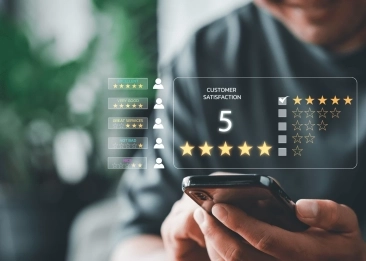
In the competitive roofing industry, having a strong online presence is crucial for attracting new customers. When potential clients search for roofing services, they are most likely to click on one of the top results on Google’s first page. Therefore, optimizing your roofing website to rank high in search engine results is essential for generating leads and growing your business.
Search Engine Optimization (SEO) is the key to achieving this. SEO is a set of strategies and practices aimed at improving your website’s visibility in search engine results pages (SERPs). In this comprehensive guide, we’ll explore the top SEO tips to help your roofing website climb to Google’s first page.
1. Conduct Thorough Keyword Research
Keyword research is the foundation of any successful SEO strategy. It involves identifying the words and phrases that potential customers are using to search for roofing services. Here’s how to conduct effective keyword research:
- Use Keyword Research Tools: Tools like Google Keyword Planner, Ahrefs, SEMrush, and Ubersuggest can help you discover relevant keywords with high search volume and low competition. Focus on both short-tail keywords (e.g., “roofing contractor”) and long-tail keywords (e.g., “affordable roof repair in [City]”).
- Target Local Keywords: Since roofing services are location-based, it’s crucial to target local keywords that include your city or region. For example, “roof replacement in [City]” or “best roofing company in [City].” Local keywords help you rank higher in local search results, making it easier for nearby customers to find you.
- Analyze Competitors: Look at the keywords your competitors are ranking for. Tools like Ahrefs allow you to see which keywords are driving traffic to their websites. This can give you insights into potential keyword opportunities that you may have overlooked.
- Focus on Buyer Intent: Prioritize keywords that indicate a high intent to hire a roofing contractor. Keywords like “roof repair cost,” “emergency roof repair,” and “roof installation estimate” suggest that the user is actively seeking roofing services and is more likely to convert into a lead.
2. Optimize Your Website’s On-Page SEO
On-page SEO refers to the optimization of individual pages on your website to improve their search engine rankings. Here are some key on-page SEO strategies:
- Title Tags and Meta Descriptions: Each page on your website should have a unique title tag and meta description that includes your target keywords. The title tag should be around 60 characters long and clearly describe the page’s content. The meta description should be a brief summary of the page, around 150-160 characters, and include a call to action.
- Header Tags (H1, H2, H3): Use header tags to structure your content and make it easier for search engines to understand. The H1 tag should include the main keyword and serve as the page’s primary headline. Use H2 and H3 tags for subheadings to break up your content and make it more readable.
- Keyword Placement: Naturally incorporate your target keywords throughout your content, especially in the first 100 words, headers, and concluding paragraphs. However, avoid keyword stuffing, which can lead to penalties from search engines. The goal is to make your content flow naturally while still optimizing it for search engines.
- Internal Linking: Link to other relevant pages on your website using anchor text that includes your target keywords. Internal linking helps search engines crawl your site more effectively and distributes page authority across your website.
- Image Optimization: Optimize images by compressing their file sizes to improve page load speed. Use descriptive file names and alt tags that include relevant keywords. Alt tags help search engines understand what the image is about and improve accessibility for users with visual impairments.
- URL Structure: Create clean, descriptive URLs that include your target keywords. For example, “www.yourroofingcompany.com/roof-repair-services” is more SEO-friendly than “www.yourroofingcompany.com/page123.”
3. Create High-Quality, Relevant Content
Content is the backbone of SEO. High-quality, relevant content not only helps you rank higher in search engine results but also engages your audience and establishes your authority in the roofing industry. Here’s how to create effective content:
- Focus on Your Audience: Create content that addresses the needs, questions, and pain points of your target audience. For example, write blog posts that answer common roofing questions, such as “How to Choose the Right Roofing Material” or “Signs You Need a Roof Replacement.”
- Content-Length: Long-form content generally performs better in search engine rankings. Aim for blog posts that are at least 1,500 words long. This allows you to cover topics in-depth and provides more opportunities to include relevant keywords.
- Regular Updates: Keep your website fresh by regularly updating your blog with new content. Search engines favor websites that consistently publish fresh content, as it indicates that the site is active and relevant.
- Include Multimedia: Enhance your content with images, videos, infographics, and other multimedia elements. These not only make your content more engaging but also provide additional opportunities for SEO optimization.
- Answer User Intent: Ensure that your content directly answers the search intent behind your target keywords. If someone searches for “roof repair costs,” they expect to find detailed information about roofing prices, factors that affect costs, and tips for budgeting.
4. Build a Strong Backlink Profile
Backlinks, or inbound links, are links from other websites to your own. Search engines view backlinks as a vote of confidence in your content’s quality and authority. Building a strong backlink profile is crucial for improving your website’s ranking. Here’s how to do it:
- Guest Blogging: Write guest posts for reputable websites in the home improvement or construction industry. Include a link back to your website in your author bio or within the content. Guest blogging helps you reach a wider audience and earn valuable backlinks.
- Local Citations: Ensure your business is listed in local directories, such as Yelp, Angie’s List, and the Better Business Bureau. These local citations often include a link to your website, boosting your local SEO.
- Partnerships and Sponsorships: Partner with local businesses, charities, or events and ask for a backlink in return. Sponsorships, such as sponsoring a local sports team or community event, can also result in backlinks from the organization’s website.
- Create Link-Worthy Content: Produce high-quality content that others in the industry will want to link to. This could be an in-depth guide, a research report, or an infographic that provides valuable information to your audience.
- Monitor Backlinks: Use tools like Ahrefs or Moz to monitor your backlink profile. Identify any low-quality or spammy backlinks and disavow them to avoid penalties from search engines.
5. Optimize for Local SEO
As a roofing business, your primary audience is local customers. Local SEO helps you rank higher in local search results, making it easier for potential customers in your area to find you. Here’s how to optimize your website for local SEO:
- Google Business Profile Optimization: Claim and optimize your Google Business Profile (formerly Google My Business). Ensure all information is accurate, including your business name, address, phone number, and hours of operation. Add high-quality photos of your work, respond to customer reviews, and post regular updates to keep your profile active.
- Local Keywords: Incorporate local keywords into your website content, meta tags, and headers. For example, use phrases like “roofing services in [City]” or “roof repair near [City].” Local keywords help you rank higher in location-based searches.
- Location Pages: If you serve multiple areas, create dedicated location pages for each area. These pages should include unique content specific to the location, such as customer testimonials, completed projects, and local landmarks.
- NAP Consistency: Ensure your business name, address, and phone number (NAP) are consistent across all online listings, including your website, social media profiles, and local directories. Consistent NAP information helps search engines verify your business’s location and improves your local rankings.
- Local Link Building: Focus on earning backlinks from local websites, such as local news outlets, blogs, and business associations. These local backlinks carry more weight in local SEO and can significantly boost your rankings.
6. Enhance User Experience (UX) on Your Website
Google’s algorithms prioritize websites that offer a positive user experience. A website that is fast, easy to navigate, and mobile-friendly is more likely to rank higher in search engine results. Here’s how to enhance the UX on your roofing website:
- Mobile Optimization: Ensure your website is fully responsive and provides a seamless experience on all devices, including smartphones and tablets. A mobile-friendly design is crucial, as a significant portion of web traffic comes from mobile users.
- Page Load Speed: Google considers page load speed as a ranking factor. Use tools like Google PageSpeed Insights to identify and fix issues that may be slowing down your website. Compress images, use a content delivery network (CDN), and enable browser caching to improve load times.
- Easy Navigation: Your website should be easy to navigate, with a clear menu structure and intuitive layout. Users should be able to find the information they need quickly and easily.
- Clear CTAs: Include clear and prominent calls to action (CTAs) on every page. Whether it’s scheduling a free inspection, requesting a quote, or calling your office, make sure the CTA is easy to find and encourages users to take the next step.
- Secure Website (HTTPS): Ensure your website is secure by using HTTPS encryption. A secure website is not only essential for protecting user data but is also a ranking factor in Google’s algorithms.
7. Utilize Social Media to Boost SEO
While social media signals don’t directly impact search engine rankings, a strong social media presence can indirectly boost your SEO efforts by driving traffic to your website and increasing brand visibility. Here’s how to leverage social media for SEO:
- Share Content Regularly: Share your blog posts, videos, and other content on your social media platforms. Encourage your followers to visit your website and share your content with their networks.
- Engage with Your Audience: Respond to comments, messages, and reviews on your social media profiles. Engaging with your audience builds trust and encourages more interaction, which can lead to increased website traffic.
- Encourage Social Sharing: Add social sharing buttons to your blog posts and other content. Make it easy for readers to share your content on their social media platforms, increasing your reach and driving more traffic to your website.
- Use Hashtags: Use relevant hashtags to increase the visibility of your social media posts. Hashtags help users discover your content and can lead to more website visits.
- Collaborate with Influencers: Partner with local influencers or industry experts to promote your roofing services on social media. Influencers can help amplify your content and drive more traffic to your website.
8. Monitor and Analyze Your SEO Performance
SEO is an ongoing process that requires regular monitoring and optimization. By tracking your performance, you can identify what’s working and what needs improvement. Here’s how to monitor and analyze your SEO efforts:
- Use Google Analytics: Google Analytics is a powerful tool for tracking website traffic, user behavior, and conversion rates. Use it to monitor key metrics, such as organic traffic, bounce rate, average session duration, and goal completions.
- Set Up Google Search Console: Google Search Console provides insights into how your website is performing in search results. You can see which keywords are driving traffic, identify any crawl errors, and monitor your site’s indexing status.
- Track Keyword Rankings: Use tools like Ahrefs, SEMrush, or Moz to track your keyword rankings over time. Identify keywords that are performing well and those that need further optimization.
- Analyze Competitors: Regularly analyze your competitors’ websites to see how they are ranking and what strategies they are using. This can give you ideas for new keywords to target or content to create.
- Adjust Your Strategy: Based on your analysis, make adjustments to your SEO strategy as needed. Whether it’s updating content, targeting new keywords, or building more backlinks, continuous optimization is key to maintaining and improving your rankings.
Ranking your roofing website on Google’s first page requires a combination of effective keyword research, on-page optimization, high-quality content, backlink building, and local SEO strategies. By following these top SEO tips and continuously optimizing your efforts, you can improve your search engine rankings, drive more organic traffic to your website, and generate high-quality leads for your roofing business.
Remember, SEO is not a one-time effort but an ongoing process that requires regular monitoring, analysis, and adjustments. Stay up-to-date with the latest SEO trends and algorithm changes to ensure your roofing website remains competitive in the ever-evolving digital landscape. With the right approach, you can achieve long-term success and dominate the search engine results in your local market.











